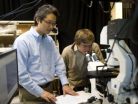(Press-News.org) WEST LAFAYETTE, Ind. - Researchers are creating a new type of solar cell designed to self-repair like natural photosynthetic systems in plants by using carbon nanotubes and DNA, an approach aimed at increasing service life and reducing cost.
"We've created artificial photosystems using optical nanomaterials to harvest solar energy that is converted to electrical power," said Jong Hyun Choi, an assistant professor of mechanical engineering at Purdue University.
The design exploits the unusual electrical properties of structures called single-wall carbon nanotubes, using them as "molecular wires in light harvesting cells," said Choi, whose research group is based at the Birck Nanotechnology and Bindley Bioscience centers at Purdue's Discovery Park.
"I think our approach offers promise for industrialization, but we're still in the basic research stage," he said.
Photoelectrochemical cells convert sunlight into electricity and use an electrolyte - a liquid that conducts electricity - to transport electrons and create the current. The cells contain light-absorbing dyes called chromophores, chlorophyll-like molecules that degrade due to exposure to sunlight.
"The critical disadvantage of conventional photoelectrochemical cells is this degradation," Choi said.
The new technology overcomes this problem just as nature does: by continuously replacing the photo-damaged dyes with new ones.
"This sort of self-regeneration is done in plants every hour," Choi said.
The new concept could make possible an innovative type of photoelectrochemical cell that continues operating at full capacity indefinitely, as long as new chromophores are added.
Findings were detailed in a November presentation during the International Mechanical Engineering Congress and Exhibition in Vancouver. The concept also was unveiled in an online article (http://spie.org/x41475.xml?ArticleID=x41475) featured on the Web site for SPIE, an international society for optics and photonics.
The talk and article were written by Choi, doctoral students Benjamin A. Baker and Tae-Gon Cha, and undergraduate students M. Dane Sauffer and Yujun Wu.
The carbon nanotubes work as a platform to anchor strands of DNA. The DNA is engineered to have specific sequences of building blocks called nucleotides, enabling them to recognize and attach to the chromophores.
"The DNA recognizes the dye molecules, and then the system spontaneously self-assembles," Choi said
When the chromophores are ready to be replaced, they might be removed by using chemical processes or by adding new DNA strands with different nucleotide sequences, kicking off the damaged dye molecules. New chromophores would then be added.
Two elements are critical for the technology to mimic nature's self-repair mechanism: molecular recognition and thermodynamic metastability, or the ability of the system to continuously be dissolved and reassembled.
The research is an extension of work that Choi collaborated on with researchers at the Massachusetts Institute of Technology and the University of Illinois. The earlier work used biological chromophores taken from bacteria, and findings were detailed in a research paper published in November in the journal Nature Chemistry (http://www.nature.com/nchem/journal/v2/n11/abs/nchem.822.html).
However, using natural chromophores is difficult, and they must be harvested and isolated from bacteria, a process that would be expensive to reproduce on an industrial scale, Choi said.
"So instead of using biological chromophores, we want to use synthetic ones made of dyes called porphyrins," he said.
INFORMATION:
Writer: Emil Venere, 765-494-4709, venere@purdue.edu
Source: Jong Hyun Choi, 765-496-3562, jchoi@purdue.edu
Related website:
Jong Hyun Choi: https://engineering.purdue.edu/~jchoi/
PHOTO CAPTION:
Jong Hyun Choi, an assistant professor of mechanical engineering at Purdue, and doctoral student Benjamin Baker use fluorescent imaging to view a carbon nanotube. Their research is aimed at creating a new type of solar cell designed to self-repair like natural photosynthetic systems. The approach might enable researchers to increase the service life and reduce costs for photoelectrochemical cells, which convert sunlight into electricity. (Purdue University photo/Mark Simons)
A publication-quality photo is available at http://news.uns.purdue.edu/images/2011/choi-solar.jpg
Abstract on the research in this release is available at: http://www.purdue.edu/newsroom/research/2011/110104ChoiSolar.html
New solar cell self-repairs like natural plant systems
2011-01-06
ELSE PRESS RELEASES FROM THIS DATE:
Wake up and smell the willow
2011-01-06
More plant matter could be burned in coal-fired power stations if this 'green' fuel was delivered pre-roasted like coffee beans, according to researchers from the University of Leeds, UK.
Many UK power stations are now burning plant matter, or biomass, as well as coal in a bid to cut their carbon footprint. Unlike fossil fuels, plants like willow, Miscanthus and poplar are a virtually carbon-neutral source of energy: the carbon dioxide emitted when they burn is absorbed during photosynthesis by the next batch of 'energy crops' planted in their place.
But the environmental ...
US does not have infrastructure to consume more ethanol
2011-01-06
WEST LAFAYETTE, Ind. - The United States doesn't have the infrastructure to meet the federal mandate for renewable fuel use with ethanol but could meet the standard with significant increases in cellulosic and next-generation biofuels, according to a Purdue University study.
Wally Tyner, the James and Lois Ackerman Professor of Agricultural Economics, and co-authors Frank Dooley, a Purdue professor of agricultural economics, and Daniela Viteri, a former Purdue graduate student, used U.S. Department of Energy and Environmental Protection Agency data to determine that the ...
Environmental Science & Technology special issue on environmental policy now online
2011-01-06
WASHINGTON, Jan. 4, 2011 — A special edition of the American Chemical Society journal, Environmental Science & Technology (ES&T), one of the world's premier environmental journals, is available now for a limited time online without charge. The special edition will be accessible free during 2011, when the world celebrates the International Year of Chemistry.
Entitled "Environmental Policy: Past, Present, and Future," the special issue of ES&T recognizes closure of a "green" decade in which people became more aware of environmental issues, and society marked the 40th anniversaries ...
Vaccine blocks cocaine high in mice
2011-01-06
NEW YORK (Jan. 4, 2011) — Researchers have produced a lasting anti-cocaine immunity in mice by giving them a safe vaccine that combines bits of the common cold virus with a particle that mimics cocaine.
In their study, published Jan. 4 in the online edition of Molecular Therapy and funded by the National Institute on Drug Abuse, the researchers say this novel strategy might be the first to offer cocaine addicts a fairly simple way to break and reverse their habit, and it might also be useful in treating other addictions, such as to nicotine, heroin and other opiates.
...
VCU findings may help explain some major clinical symptoms of preeclampsia
2011-01-06
RICHMOND, Va. (Jan. 4, 2011) – Virginia Commonwealth University School of Medicine researchers have found that a significant increase of an enzyme in the blood vessels of pregnant women with preeclampsia may explain some of the symptoms associated with the condition, including hypertension, swelling and protein in the urine.
The findings could lead to a treatment for pregnant women with preeclampsia, which is one of the most significant health problems in pregnancy and a leading cause worldwide of both premature delivery and of sickness and death of the mother and baby.
Preeclampsia, ...
Scientists discover that a specific enzyme inhibitor may help control lung inflammation
2011-01-06
All of us may be able to breathe a little easier now that scientists from Pennsylvania have found a new therapeutic target for controlling dangerous inflammation in the lungs. A new research report in the January 2011 issue of the Journal of Leukocyte Biology (http://www.jleukbio.org) suggests that blocking the activation of an enzyme called delta-protein kinase C (delta-PKC) could protect the lungs from neutrophil-mediated damage, which can result in out of control inflammation. In an animal model of acute respiratory distress syndrome (ARDS), inhibiting delta-PKC in ...
A new drug target in atherosclerosis: The anaphylatoxin C5a
2011-01-06
For decades, doctors have looked at fitness levels, weight, and overall health risk factors for heart disease and stroke. Now, they may soon add a new risk factor to the list: activation of the complement system. The complement system is usually implicated in immune responses, but now there's a role for it in cardiovascular disease. In a new research report appearing in the January 2011 print issue of the FASEB Journal (http://www.fasebj.org), scientists from Europe and the United States show that anaphylatoxin C5a, a protein released when complement is activated, contributes ...
Mercyhurst pioneers game-based learning in teaching strategic intelligence
2011-01-06
Kris Wheaton pushes a key on his computer and the reminder transmits to dozens of intelligence studies students: Game Lab Tonight!
Himself a long-time gamer, Wheaton is a pioneer in game-based learning as it applies to the teaching of intelligence analysis.
Whether wrangling over the next move in "Defiant Russia," a board game based on the 1941 German attack on the Soviet Union, where players control the units that fought in the campaign; or strategizing over the online musical puzzle journey that is "Auditorium," there's lots of learning going on.
"In terms of ...
Watch out for that boom
2011-01-06
PROVIDENCE, RI – Just as the site for the 2013 America's Cup has been announced, a study from Rhode Island Hospital highlights that the sport isn't always smooth sailing. The study was published recently in the journal Wilderness and Environmental Medicine.
Through an on-line survey completed by sailors, researchers at Rhode Island Hospital have pieced together a report of the injuries that occur on two types of boats -- dinghies (small boats with crews of one or two) and keel boats (larger boats like those used in the America's Cup races with a crew of up to 16).
With ...
Recycled Haitian concrete can be safe, strong and less expensive, says Georgia Tech group
2011-01-06
WESTERVILLE, OH – Nearly one year after a 7.0-magnitude earthquake rocked the Republic of Haiti, engineering and concrete experts at Georgia Tech report that concrete and other debris in Port-au-Prince could be safely and inexpensively recycled into strong new construction material.
In a paper published today in the Bulletin of the American Ceramic Society, researchers Reginald DesRoches, Kimberly E. Kurtis and Joshua J. Gresham say that they have made new concrete, which meets or exceeds the minimum strength standards used in the United States, from recycled concrete ...

